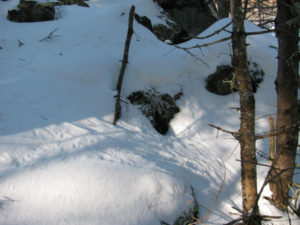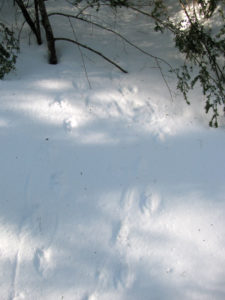(Photos and story by Diane De Luca)

Frigid temperatures, a hard snow pack and a couple inches of fresh snow create the perfect conditions for observing tracks. I head out across a frozen Black Fox Pond in the hopes of discovering some of the fascinating snow stories that might otherwise go untold. Many animals are nocturnal and move around under the protection of dense cover. Thanks to the newly fallen snow, clues may be revealed as to how they live.

Tracks head across in the same direction I am traveling. The straight path of a fox, the meanderings of two coyotes. Deep coves define the shoreline of this pond, and I head up one that leads to an adjacent marshy area with a backdrop of rocky outcroppings. Hemlocks line the pond here. This year they are thick with cones, bending low over the edge. Pieces of bark, twigs, and needles are scattered across the snow beneath the overhanging hemlocks.

I duck under the hemlocks and move toward the rock jumble. A path is evident in the snow that leads across the marsh, and around many of the large rocks that seem to spill from the cliff. It has been traveled numerous times, and reveals comings and goings into the rock openings. The tracks form a trough through the snow but here and there I can see a distinctive footprint and tail drag…. identifying them as porcupine.

Porcupine will create a path through the snow from the den to a nearby tree to feed, sometimes visiting the same tree for days or weeks. A porcupine climbs up into the tree, using its tail to brace itself against the tree while it gather twigs and foliage, or gnaw the bark. Pieces of bark, twigs, and conifer needles can litter the snow beneath a tree in which a porcupine forages. It is one of my first clues to their presence at the edge of the pond.

At most times of the year, the porcupine is a solitary creature. With their well-developed quill defense, they do not need to live in groups to protect themselves. During the winter, however, they may den with other porcupines. Rocky outcroppings are a preferred den but they will also use hollow logs or trees. They do not hibernate, but seek protection of the dens in bad weather. Dense guard hairs and a thick layer of fat keep porcupine warm. Mainly nocturnal, the preferred winter food in New Hampshire is hemlock.
